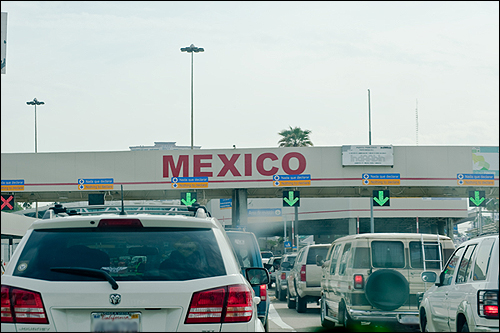 By Mónica Ortiz Uribe, KJZZ News for Fronteras
By Mónica Ortiz Uribe, KJZZ News for Fronteras
EL PASO – Of over 11 million undocumented immigrants in this country, some 40 percent actually entered the U.S. legally. They came on a temporary visa. Trouble is once they got here, they decided to stay. Tracking them down is one of the biggest challenges facing the Department of Homeland Security.
It all starts here.
CONSULATE STAFFER: “Welcome to the US Consulate General in Ciudad Juarez, Mexico. We are the largest visa processing post in the entire world….”
If you live in Mexico or anywhere else in the world and want to take a vacation or study in the United States, the starting point is your nearest U.S. consulate. Here in Ciudad Juárez the consulate can process up to 1000 applications a day. Olga Bashbush is a spokeswoman for the consulate in Juarez.
OLGA BASHBUSH: “People have to demonstrate what we call ties to their country of origin…If you’re an adult, that you have job here; if you are student that you’re going to school; that you have family, relatives, you have some sort of life to go back to.”
In other words they want to be sure you’ll go home before your visa expires. Last year close to 9 million people received temporary visas to the U.S. Like this college student, originally from Argentina, who came here 10 years ago.
STUDENT: “I came to the US when I was 14-years old…I came like most people on vacation to go to Disneyland…and after the three months I stayed here.”
She overstayed her visa and now lives in California. She asked that we not use her name.
STUDENT: “I began to be involved in school, participate in clubs, honor classes. I was in the tennis team, so I thought this is, this was like a dream.”
But not entirely. She can’t legally drive or work. And unless she commits a serious crime, she’s unlikely to get caught. Historically, the U.S. government hasn’t aggressively pursued visa violators.
EDWARD ALDEAN: “It’s not surprising that a fair number of people thought, well this is a way to come to the United States and continue to live in the United States…”
Edward Alden studies immigration policy for the Council of Foreign Relations in Washington.
ALDEAN: “Immediately the concern about visa overstays is that it potentially could be a way for terrorists to come and remain in the United States. Several of the 9/11 high jackers had come on legal visas and then overstayed…”
After 9/11, the Department of Homeland Security started programs to prevent potentially dangerous foreigners from getting a temporary visa. Other programs attempt to better track foreigners. For example, the U.S. Visit Program collects biographical data and fingerprints from foreign visitors. According to Alden, the program is fairly successful at tracking arrivals and departures from airports. But land crossings are another story.
At the southern ports of entry, like this one in El Paso, customs agents document the entry of all travelers. But on the other side no one is tracking their exits. With 350 million southern border crossers each year, DHS claims tracking exits may be logistically and financially unrealistic. Media liaisons from multiple DHS branches refused to be interviewed for this story.
DIANNE FEINSTEIN: “For many years I’ve been trying to get data on visa overstays from each country to no avail so far.”
Reporters aren’t the only ones searching for answers. That’s California Senator Dianne Feinstein at a Congressional hearing last month. She posed her question to DHS Secretary Janet Napolitano who promised more overstay data later this year. The issue is a critical puzzle piece in the ongoing debate over immigration reform.
Edward Alden of the Council on Foreign Relations has one suggestion: send foreigners an email notice a couple weeks before their visa expires.
ALDEAN: “There’s plenty of social science evidence that individuals are far more likely to follow the law if they think someone is watching them.”
Without stricter enforcement, critics contend the problem of visa violators will simply continue.




